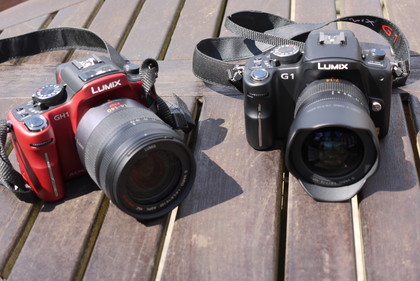Hands on: Panasonic Lumix GH1 review
Panasonic adds video to its Micro Four Thirds stunner
After an afternoon handling the GH1 at its UK launch, we were impressed with just how much well the camera performs. Although we were given a pre-production model to play with, everything that was right about the G1 is included plus that little bit more.
The body is impressively compact (3.3 x 4.9 x 1.8 inches) and light. The chassis is a mixture of plastic and metal, and the red style we were given meant that aesthetically the camera is pleasing – a nice change from the normal black.

SAME DIFFERENCE: The GH1 uses the same chassis as the G1
Using a 14-140 Lumix HD lens, shooting was fairly simple. There's a chunky Mode dial on the right-hand side, with the normal range of settings (Auto, Program, Manual. Scene etc), underneath this is the on/off button and connected to the dial is a quick switch to the various 'multiple shot' modes.
While you could spend hours tweaking and adjusting with the features the in-camera menus bring, for those who want to point and shoot, the option is there.
Capturing portraits is a cinch with the cameras 23-point autofocus system works extremely quickly, meaning that even the Mr Magoo's of the camera world will be able to film a friendly face in focus. Couple this with the Face Recognition feature and you are laughing.
And even though there are modes for both pets and babies, the cameras shoot speed feels a little sluggish at times, so unless you have patient subjects you are going to have some interesting photographs.
Get daily insight, inspiration and deals in your inbox
Sign up for breaking news, reviews, opinion, top tech deals, and more.

FOCAL POINT: The camera's autofocus is impressive, even when working overtime
Like its stable mate, the GH1 makes good use of an electronic viewfinder. Instead of lining up your shots with the LCD, put the camera to your eye and it will automatically squeeze the view into the eyepiece. It's a fair swap for an optical viewfinder – the reason the Micro Four Thirds system is smaller is that it has done away with the mirrors needed for an optical viewfinder – and worked just as well in the time we played with it, with little judder or grain you usually associate with this type of digital technology.
Marc Chacksfield is the Editor In Chief, Shortlist.com at DC Thomson. He started out life as a movie writer for numerous (now defunct) magazines and soon found himself online - editing a gaggle of gadget sites, including TechRadar, Digital Camera World and Tom's Guide UK. At Shortlist you'll find him mostly writing about movies and tech, so no change there then.
